|
|
|
|
|
|
|
|
|
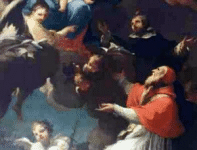
Via Angelica
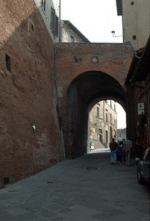
Porta
Toppariorum
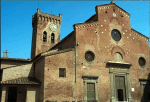
pieve di Santa Maria del 1100
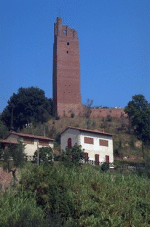
Torre di Matilde 1100
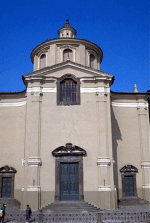
il
Santissimo Crocifisso
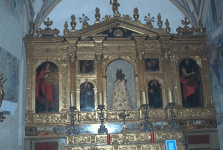
Oratorio del Loretino
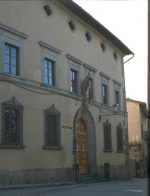
Palazzo
Migliorati
|
Such a history
could not but leave an important artistic and
architectural heritage. A short tour of the town
can begin with the central Piazza del Popolo, with
its fourteenth century church of San Domenico,
rich with works of art such as a fresco of St.
Anselmo, attributed by Longhi and Berenson to
Masolino da Panicale, and a sepulchral monument by
Donatello.
To the left of the church’s facade is the amazing
Via Angelica, an underground passageway leading
from the walls that connected the city to the
countryside, where chapels of the ancient convent
can be seen. To the right are the convent’s
cloisters which were confiscated and opened to the
populace during Napoleon’s rule. Here the
Historical Archives are kept, one of the richest
in Tuscany with over one hundred thousand
documents dating back to 1200, including the
ancient City Statutes.
Continuing on, examples of Renaissance
architecture can be seen including the Palazzo
Formichini, housing the Cassa di Risparmio’s art
collection (with works by Guercino, Lorenzo di
Bicci, Jacopo del Sellaio, Cigoli and
Giovanbattista Naldini), and particularly the
Palazzo Grifoni, built in 1555 by Giuliano di
Baccio d'Agnolo. Proceeding downhill is the
octagonal shaped church of the Santissima
Annunziata that contains the relics of St. Dorothy,
and the Monastery of St. Clare, another museum
with works by Cigoli, Deodato Orlandi, Jacopo
Chimenti and panels from fifteenth century Sienese
and Florentine schools.
Going in the opposite direction from San Domenico
you reach the old castle area. After passing the
Palazzo Roffia, also by Giuliano di Baccio d’Agnolo,
you proceed though the Porta Toppariorum which
gives access to the core of the ancient defence
complex. Inside the Gate is the Casatorre degli
Stipendiari, built by Frederick to house the
military contingent, and today an exhibition area.
Ahead is the scenic Piazza del Seminario, closed
off by the other medieval door called the Ruga.
Through a three-way access from the Piazza, you
can go up to the Piazza del Duomo. Ruins dating
back to the 11th century of the tower and the
Palazzo Imperiale (Imperial Palace) can be seen
here, where four Germanic emperors stayed as
guests of the Swevian and Othan vicars: Otto I of
Saxony in 962, Frederick Barbarossa in 1167 and
again in 1178, Otto IV in 1209 and Frederick II of
Swabia in 1218, 1226 and in 1240. Facing it is the
Palazzo Vescovile (Bishop’s Palace), erected in
the fourteenth century over three pre-existing
buildings. In front of it is the Cathedral, the
ancient parish of Holy Mary dating back to 1100
which retains its Romanesque facade.
Next to it is the Museo Diocesano d’Arte Sacra
(the Diocesan Museum of Religious Art), which
houses many works including a Redeemer by
Verrocchio and a Crucifixion by Filippino Lippo.
Behind it stands the Torre di Matilde, erected in
1100 and which later became part of the Cathedral
as its bell tower. Above it is the fortress and
surrounding walls dating back to Frederick II’s
time. Here, as Dante writes in the XIII canto of
his Inferno, Frederick’s advisor Pier delle Vigne
fell out of grace and was imprisoned and left to
die.
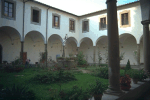
San
Francesco
The massive
fourteenth century convent of San Francesco is located
on the slope of the highest hill and was for many
centuries one of the most flourishing Franciscan
centres in Tuscany. In the fifteenth century it was
run by the Blessed Borromeo and Bernard, who later
taught at Oxford and the Sorbonne. On the other side
of the hill is the Santissimo Crocifisso (Holy
Crucifix), an important Sanctuary in the form of a
Greek Cross by Anton Maria Ferri in 1705 containing an
11th century wooden cross that is venerated and
thought to be miraculous.
In front of the Sanctuary is the Palazzo del Commune
(Town Hall), with its frescoed rooms and nineteenth
century facade, and the Oratorio del Loretino (Oratory
of Loretino), with panels by Francesco Lanfranchi,
brother of Andrea Del Sarto, and a wooden altar from
1527. As you descend the hill, amidst early Middle Age
churches and palaces, is the historical Piazza
Bonaparte with its monument to Leopold, Grand Duke of
Tuscany by Pampaloni and the Oratory of San Rocco, the
ancient chapel of the Buonaparte family.
Lastly, continuing towards the ruined Porta di
Poggighisi (Poggighisi Gate), from where Francesco
Ferrucci conquered the city in 1530, is the Church of
Santa Caterina, altered in the 15th century and
housing the skeleton of St. Boniface the martyr, and
the sixteenth century Palazzo Migliorati, home today
of the Accademia degli Euteleti, where the funeral
mask of Napoleon is kept.
 FOTO GALLERY
MUSEI
FOTO GALLERY
MUSEI
MONUMENTI
CHIESE
|
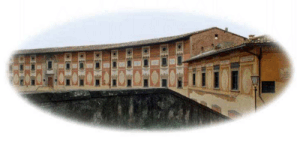
Piazza del
Seminario |
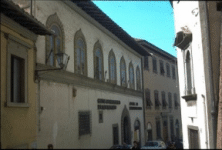
Palazzo Roffia |
|
|
 |
Pisa Ricettività in tutta la
provincia:
Hotels, Agriturismi, Residence,
Ostelli, Campeggi, B&B,
Affittacamere, Alberghi, Casa
Vacanza, etc.. |
> Volterra Hotel, Agriturismi, Holiday Farms |
|
|
|
|
|
|
|
|